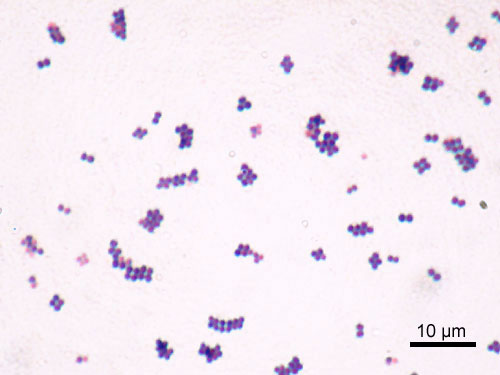Bergeys Manual Staphylococcus Aureus
Bergey's Manual Staphylococcus Saprophyticus The API Staph-Ident system was more accurate in correctly identifying Staphylococcus aureus (93.9%) than in correctly identifying non-S. Aureus species. Thus it is confirmed that Staphylococcus saprophyticus isolates Staphylococcus saprophyticus according to bergey's manual of bacteriological. We found that the use of the nomenclature of Bergey's Manual (8th edition) to identify these strains by species was not adequate. DNA homology values supported the formation of Staphylococcus hyicus subsp. Hyicus separate from Staphylococcus aureus, Staphylococcus epidermidis, and Staphylococcus.
Abstract
A total of 158 Staphylococcus strains from various sources were characterized by biochemical, physiological, and morphological tests. Numerical taxonomy was applied by using these features. Taxonomic analysis was done with programs run under the MVS-TSO system of the IBM 370 complex and PDP-10 system of the National Institutes of Health. DNA-DNA hybridization with nitrocellulose filters was done to compare selected atypical cultures with American Type Culture Collection reference strains. We found that the use of the nomenclature of Bergey's Manual (8th edition) to identify these strains by species was not adequate. DNA homology values supported the formation of Staphylococcus hyicus subsp. hyicus separate from Staphylococcus aureus, Staphylococcus epidermidis, and Staphylococcus saprophyticus. The three tests that best separated these strains into four species were (i) tube coagulase (6-h or 24-h porcine plasma or 24-h Difco rabbit plasma), (ii) production of acetoin or acid aerobically from ribose, maltose, or trehalose, and (iii) growth in the presence of novobiocin. Four strains of S. hyicus subsp. hyicus (VII76, VII113, VII131, and VA519) gave typical enterotoxigenic responses in monkey-feeding tests but were negative for enterotoxins A through E, suggesting the presence of one or more new enterotoxins. Two coagulase-negative, heat-stable DNase-positive strains (D143 and ARM) could not be classified by either DNA-DNA hybridization or numerical taxonomy, and D143 was enterotoxigenic as measured by the monkey-feeding bioassay. DNA homology showed that strain FRI-698M was more closely related to S. epidermidis than to S. aureus, yet it produced enterotoxin D. These data suggest the occurrence of coagulase-negative enterotoxigenic strains that are not S. aureus; nonetheless, a positive tube coagulase test and heat-stable DNase test should together be useful for routine screening of most potentially enterotoxigenic staphylococci in foods.
Full text
Full text is available as a scanned copy of the original print version. Get a printable copy (PDF file) of the complete article (1.6M), or click on a page image below to browse page by page. Links to PubMed are also available for Selected References.
These references are in PubMed. This may not be the complete list of references from this article.
Staphylococcus Aureus Gram Stain
- BAIRD-PARKER AC. THE CLASSIFICATION OF STAPHYLOCOCCI AND MICROCOCCI FROM WORLD-WIDE SOURCES. J Gen Microbiol. 1965 Mar;38:363–387. [PubMed] [Google Scholar]
- Baker RF. Binding of DNA to cellulose nitrate filters under denaturing conditions. Anal Biochem. 1977 Apr;78(2):569–571. [PubMed] [Google Scholar]
- Casman EP, Bennett RW, Dorsey AE, Stone JE. The micro-slide gel double diffusion test for the detection and assay of staphylococcal enterotoxins. Health Lab Sci. 1969 Oct;6(4):185–198. [PubMed] [Google Scholar]
- Danielsson ML, Hellberg B. The biochemical activity of enterotoxin and non-enterotoxin producing staphylococci. Acta Vet Scand. 1977;18(2):266–273. [PubMed] [Google Scholar]
- DEIBEL RH, EVANS JB. Modified benzidine test for the detection of cytochrome-containing respiratory systems in microorganisms. J Bacteriol. 1960 Mar;79:356–360.[PMC free article] [PubMed] [Google Scholar]
- Denhardt DT. A membrane-filter technique for the detection of complementary DNA. Biochem Biophys Res Commun. 1966 Jun 13;23(5):641–646. [PubMed] [Google Scholar]
- Devriese LA, Oeding P. Coagulase and heat-resistant nuclease producing Staphylococcus epidermidis strains from animals. J Appl Bacteriol. 1975 Oct;39(2):197–207. [PubMed] [Google Scholar]
- ELEK SD, LEVY E. Distribution of haemolysins in pathogenic and non-pathogenic staphylococci. J Pathol Bacteriol. 1950 Oct;62(4):541–554. [PubMed] [Google Scholar]
- Evans JB, Kloos WE. Use of shake cultures in a semisolid thioglycolate medium for differentiating staphylococci from micrococci. Appl Microbiol. 1972 Feb;23(2):326–331.[PMC free article] [PubMed] [Google Scholar]
- Gillespie D, Spiegelman S. A quantitative assay for DNA-RNA hybrids with DNA immobilized on a membrane. J Mol Biol. 1965 Jul;12(3):829–842. [PubMed] [Google Scholar]
- Goodfellow M, Mordarski M, Tkacz A, Szyba K, Pulverer G. Polynucleotide sequence divergence among some coagulase-negative staphylococci. Zentralbl Bakteriol A. 1980 Feb;246(1):10–22. [PubMed] [Google Scholar]
- Gramoli JL, Wilkinson BJ. Characterization and identification of coagulase-negative, heat-stable deoxyribonuclease-positive staphylococci. J Gen Microbiol. 1978 Apr;105(2):275–285. [PubMed] [Google Scholar]
- Hájek V, Marsálek E. Differenzierueng pathogener Staphylokokken und Vorschlag für ihre taxonomische Klassifikation. Zentralbl Bakteriol Orig A. 1971 Jun;217(2):176–182. [PubMed] [Google Scholar]
- Jeffreys AJ, Flavell RA. A physical map of the DNA regions flanking the rabbit beta-globin gene. Cell. 1977 Oct;12(2):429–439. [PubMed] [Google Scholar]
- Kloos WE, Wolfshohl JF. Identification of Staphylococcus species with the API STAPH-IDENT system. J Clin Microbiol. 1982 Sep;16(3):509–516.[PMC free article] [PubMed] [Google Scholar]
- Lotter LP, Genigeorgis CA. Deoxyribonucleic acid base composition and biochemical properties of certain coagulase-negative enterotoxigenic cocci. Appl Microbiol. 1975 Feb;29(2):152–158.[PMC free article] [PubMed] [Google Scholar]
- Meyer SA, Schleifer KH. Deoxyribonucleic acid reassociation in the classification of coagulase-positive staphylococci. Arch Microbiol. 1978 May 30;117(2):183–188. [PubMed] [Google Scholar]
- Pennock CA, Huddy RB. Phosphatase reaction of coagulase-negative staphylococci and micrococci. J Pathol Bacteriol. 1967 Apr;93(2):685–688. [PubMed] [Google Scholar]
- Phillips WE, Jr, Kloos WE. Identification of coagulase-positive Staphylococcus intermedius and Staphylococcus hyicus subsp. hyicus isolates from veterinary clinical specimens. J Clin Microbiol. 1981 Dec;14(6):671–673.[PMC free article] [PubMed] [Google Scholar]
- Sjöquist J, Meloun B, Hjelm H. Protein A isolated from Staphylococcus aureus after digestion with lysostaphin. Eur J Biochem. 1972 Sep 25;29(3):572–578. [PubMed] [Google Scholar]
- Sperber WH. The identification of staphylococci in clinical and food microbiology laboratories. CRC Crit Rev Clin Lab Sci. 1976;7(2):121–184. [PubMed] [Google Scholar]
- Ulitzur S. Rapid determnation of DNA base composition by ultraviolet spectroscopy. Biochim Biophys Acta. 1972 Jun 22;272(1):1–11. [PubMed] [Google Scholar]
Associated Data
Bergey S Manual Staphylococcus Aureus
- Supplementary Materials
